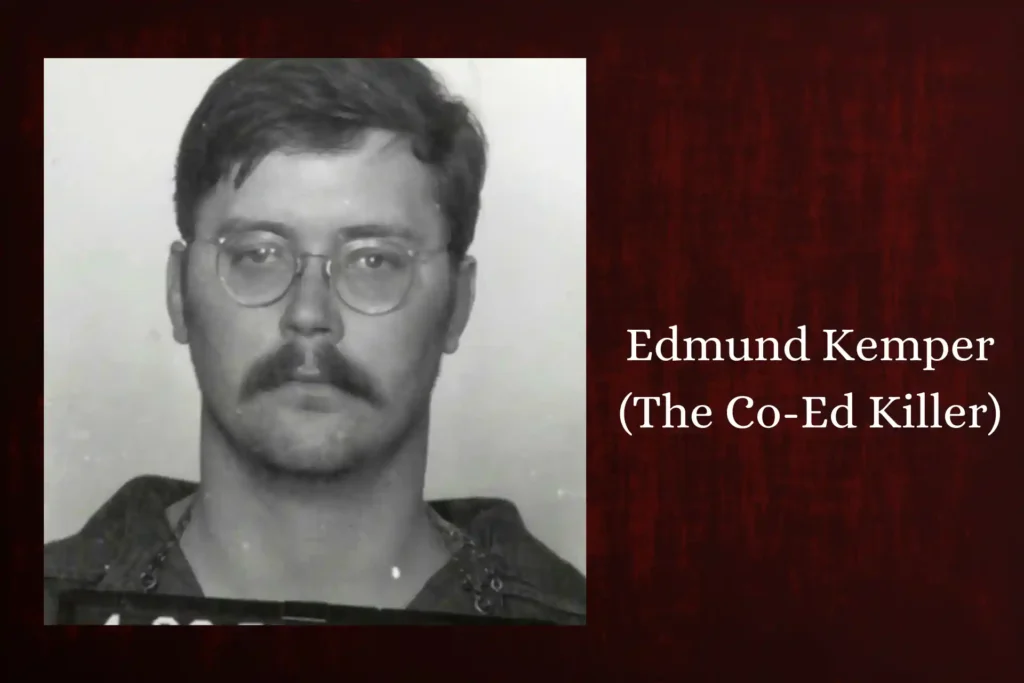In the dark corridors of American true crime, few names elicit as much fear and intrigue as Edmund Kemper, infamously dubbed the “Co-Ed Killer.” This moniker, which refers to his brutal murders of young college women in the early 1970s, encapsulates the terror he unleashed upon unsuspecting victims and their communities. His story, marked by the tragic murders of young women, serves as a stark reminder of the horrors that can lurk behind a seemingly ordinary façade.
Table of Contents
Unmasking the Co-Ed Killer: The Chilling Story of Edmund Kemper
Born on December 18, 1949, in Burbank, California, Kemper was the middle child in a dysfunctional family. His childhood was fraught with neglect and emotional abuse, particularly at the hands of his domineering mother. From an early age, he exhibited troubling behaviours, including an intense fascination with death and violence.

By the time he was a teenager, Kemper had already committed his first murders, killing his grandparents in a fit of rage. After spending nearly five years in Atascadero State Hospital, Kemper was released at the age of 21, deemed no longer a threat. However, this release marked the beginning of his reign of terror. He moved back in with his mother and quickly began targeting young women, luring them with promises of a ride or companionship. His charming persona masked a chilling reality, allowing him to exploit the vulnerability of his victims.
Kemper’s first known victims as the Co-Ed Killer were two college students, Mary Ann Pesce and Anita Luchessa, who disappeared in May 1972. He picked them up while they were hitchhiking, taking them to a remote area where he would brutally murder them. This was just the beginning; in the following months, he would go on to kill several more young women, all under similar circumstances.

Kemper’s First Taste of Blood: The Murders That Shocked a Nation
The path to infamy for Ed Kemper was paved with violence from an early age, beginning with his first murders committed at just 15 years old. In 1964, Kemper brutally killed his grandparents, William and Clara Kemper, in a shocking act that would mark the inception of his criminal career. After an argument with his grandmother, Kemper retrieved a .22 calibre rifle and shot her in the head, instantly ending her life. His grandfather, who returned home shortly after the murder, met a similar fate; Kemper shot him as well, stating that he didn’t want to leave him alive to discover what he had done.
This initial act of violence was not an isolated incident but rather a manifestation of the deep-seated rage and emotional turmoil that had been festering within Kemper for years. Raised in a tumultuous household with an abusive mother, his childhood was marked by neglect and psychological trauma. This instability fostered feelings of isolation and resentment, which would eventually erupt into lethal violence.
Following the murders of his grandparents, Kemper was diagnosed with paranoid schizophrenia and committed to the Atascadero State Hospital for the Criminally Insane. During his time in the psychiatric facility, he exhibited signs of intelligence and charm, which led many staff members to believe he could be rehabilitated. This misplaced optimism would eventually release him back into society at 21.
Upon his release, Kemper’s violent tendencies resurfaced, leading to a series of gruesome murders that would cement his status as the Co-Ed Killer. In 1972, he began targeting young women, primarily college students, using his charm and intellect to lure them into his vehicle. His method was chillingly effective; he would offer rides to hitchhikers or engage them in conversation, only to later reveal his true nature most horrifically.
The early murders of Kemper’s grandparents were a harbinger of the violence that would follow. They provided insight into the complexities of his psyche and the psychological factors that contributed to his later actions. As we delve deeper into his later crimes, it becomes evident that the roots of Kemper’s brutality were sown long before he became the infamous Co-Ed Killer.
The Modus Operandi: Seduction and Slaughter
Ed Kemper’s chilling modus operandi is a terrifying study of deception, manipulation, and cold-blooded murder. Unlike the impulsive rage that characterized his early killings, his later crimes against young women were disturbingly methodical, shaped by a strategic blend of charm and brutality. Kemper’s approach reveals a deeply calculated pattern, where seduction and murder became a macabre dance of control.
In the early 1970s, California was a hotspot for hitchhiking, especially among college students seeking convenient transportation. Kemper exploited this, offering rides to young women, many of whom were students at universities in the Santa Cruz area—hence his nickname, the “Co-Ed Killer.” Standing at a towering 6 feet 9 inches tall serial killer, Kemper was physically imposing, yet his disarming and friendly demeanour helped him appear non-threatening. This made it easy for him to gain the trust of his unsuspecting victims.

Once in his car, Kemper would engage the young women casually, putting them at ease. His intelligence and ability to relate to their youthful concerns allowed him to manipulate the situation, keeping their guard down. However, once they were isolated, the true nature of his intentions would unfold. Kemper’s well-rehearsed routine involved driving them to secluded areas where he could carry out his brutal attacks without the fear of being interrupted.
Ed Kemper’s victims were not just murdered; they were subjected to extreme violence, often involving strangulation or stabbing before being shot. What makes Kemper’s case even more disturbing is that after the murders, he would engage in necrophilia and dismemberment, further desecrating the bodies of his victims. He confessed to keeping the heads of several victims for prolonged periods, a grotesque trophy of his domination over them.
Kemper’s behaviour post-murder was equally chilling. He often returned to his regular routines after disposing of the bodies, blending back into society without raising suspicion. This sense of normalcy after committing such heinous acts underscores the depth of his psychopathy. Perhaps the most unsettling part of his modus operandi was his ability to compartmentalize his actions. Despite the horrific nature of his crimes, he could present himself as a rational and polite man, even engaging in conversations with law enforcement officers during their investigation of the murders he had committed.
Kemper’s method of seduction and murder was not purely driven by the desire to kill but by a need for control, rooted in his troubled relationship with women—especially his domineering mother. His crimes were a twisted form of rebellion, an attempt to assert dominance and power where he had once felt powerless. The ease with which he manipulated and killed his victims revealed his profound sense of superiority, making him one of the most feared and fascinating serial killers in criminal history.
Mother’s Murder
Kemper’s final two murders occurred in April of 1973. On Friday, he visited his mother’s house, where they had an unpleasant exchange. Kemper attacked his mother when she fell asleep, first hitting her in the head with a hammer and then cutting her neck with a knife. As he had with his other victims, he then decapitated her and cut off her hands, but then also removed her larynx and put it down the garbage disposal.
Kemper’s troubled relationship with his mother mirrors the disturbing family dynamics seen in cases like that of Mitchelle Blair.
After hiding her body parts, Kemper invited Sally Hallett, his mother’s friend, over to the house. Kemper strangled Hallett shortly after she came and concealed her body in a cupboard.
Kemper escaped the region the next day, driving east until he arrived in Pueblo, Colorado, on April 23, where he called Santa Cruz police to confess to his crimes. At first, they didn’t believe “Big Ed” was a murderer. But during subsequent interrogations, he would lead them to all of the evidence necessary to prove that he was the infamous “Co-ed Killer.”
Like Mark David Chapman, Kemper’s calculated and chilling confessions have left a lasting impact on the nation’s collective consciousness
The Capture: How the Co-Ed Killer Was Brought to Justice
In 1973, Kemper’s reign of terror came to an end when he turned himself in after committing a series of murders that left five women dead. His confession was chilling, revealing the calculated nature of his actions and his lack of remorse. The ensuing investigation unveiled a horrifying tapestry of violence that shocked the nation and solidified Kemper’s reputation as one of America’s most infamous serial killers.

Despite his chilling crimes, some cases in American history have shown the opposite end of the justice system—where innocent people face conviction.
The Legacy of Edmund Kemper: A Cautionary Tale
Today, Edmund Kemper is serving multiple life sentences in a California prison. His case continues to serve as a cautionary tale, raising essential questions about the nature of evil, the complexities of mental health, and the societal factors that can lead to such atrocities. Documentaries, books, and television series exploring his life have ensured that the terrifying truth of the Co-Ed Killer remains a topic of discussion.
While Kemper’s crimes were solved, many other unsolved criminal cases, such as Jack the Ripper‘s, continue to captivate the public.
Conclusion
Edmund Kemper’s story is not just one of horror; it reflects the dark complexities of the human psyche. By understanding his life and the factors that contributed to his crimes, we gain insight into the chilling reality of serial killers and the societal issues that surround them. The legacy of the Co-Ed Killer endures, reminding us of the thin line between sanity and madness.
FAQs
What were the main motivations behind Kemper’s murders?
Kemper’s motivations appear to stem from a combination of childhood trauma, a desire for control and power, and deeply rooted issues with women, mainly influenced by his abusive relationship with his mother. His killings were often characterized by an obsessive need to dominate his victims.
What ultimately led to Kemper’s arrest?
Kemper’s arrest came in April 1973 after he killed his mother following a heated argument. Following this murder, he turned himself into the police and confessed to all of his crimes, providing detailed accounts of his actions.
What lessons can be learned from Kemper’s case?
Kemper’s case highlights the importance of awareness, mental health support, and the complexities of human behaviour. It emphasizes the need for preventative measures against violence and the necessity of understanding the psychological roots of criminal behaviour.
Is Ed Kemper still alive?
Edmund Kemper is alive and is serving multiple life sentences without the possibility of parole at California State Prison, where he has been since his conviction in 1973.
How many people did Ed Kemper kill?
Edmund Kemper, infamously known as the Co-Ed Killer, murdered a total of ten people. His killing spree began in 1964 when, at the age of 15, he killed his grandparents. After a stint in a psychiatric hospital, he was released in 1969 and went on to commit several murders between 1972 and 1973, targeting young women, primarily college students, who were hitchhiking. His victims included six young women, and he also murdered his mother in 1973 following a heated argument. Kemper’s crimes were marked by extreme brutality, including acts of necrophilia and dismemberment, making him one of the most notorious serial killers in American history.